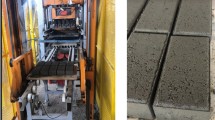Abstract
Buildings have a large urban footprint, are one of the greatest consumers of resources and raw materials, and are responsible for 40% of the global energy usage and contribute to as much as 33% of the greenhouse gas emissions worldwide. Waste wood, ground granulated blast furnace slag, and fly ash are an important source of waste that can be recycled to make wood-geopolymer concrete composite building material helping to better achieve a circular economy. The wood-geopolymer composite blocks have added properties enabling thermal, acoustic, and humidity regulation within buildings that reduce energy consumption. This study has shown that recycling partially decontaminated copper-chrome-arsenic (CCA) treated waste timber may have slightly better mechanical properties than waste virgin timber. Different amounts of wood in the wood-geopolymer composites can be used for load and non-load-bearing applications. The study has also shown that the use of less than 40% by weight of partially decontaminated CCA-treated timber in the wood-geopolymer composite blocks is able to meet the 5 mg/litre leachate limit for a wide variety of environmental leachate tests.
Access this chapter
Tax calculation will be finalised at checkout
Purchases are for personal use only
Similar content being viewed by others
References
Peng C (2016) Calculation of a building’s life cycle carbon emissions based on Ecotect and building information modelling. J Cleaner Prod 112:453–465. https://doi.org/10.1016/j.jclepro.2015.08.078
Cement Industry Federation. Australian Cement Report (2020). http://cement.org.au/wp-content/uploads/2020/08/CIFIndustry-Report-2020.pdf. Accessed 31 Aug 2023
Gallagher L (2019) Sand and sustainability: finding new solutions for environmental governance of global sand resources (2019). https://doi.org/10.13140/RG.2.2.33747.63526
Heidrich C (2020) Submission by the Ash Development Association of Australia to the ACCC, re: Boral Cement Limited application for authorisation AA1000517–interested party consultation (2020). https://www.accc.gov.au/system/files/public-registers/documents/. Submission by Ash Development Association of Australia-18.06.20-PR-AA1000517 Boral.pdf. Accessed 31 Aug 2023
ASTM C618 Standard specification for coal fly ash and raw or calcined natural pozzolan for use in concrete. ASTM, PA USA (2012)
Wang C, Kayali O, Liow JL, Troitzsch U (2023) Participation and disturbance of superplasticisers in early-stage reaction of class F fly ash-based geopolymer. Constr Build Mater 403:133176. https://doi.org/10.1016/j.conbuildmat.2023.133176
Gigar FZ, Khennane A, Liow J-L, Tekle BH, Katoozi E (2023) Recycling timber waste into geopolymer cement bonded wood composites. Constr Build Mater 400:132793. https://doi.org/10.1016/j.conbuildmat.2023.132793
Australasian (Iron & Steel) Slag Association Blast furnace slag aggregate & cementitious products, Reference data sheet 1, 4pp (2011), Australasian (iron & steel) Slag Association. https://www.asa-inc.org.au/uploads/default/files/asa_rds_1.pdf. Accessed 31 Aug 2023
Dunn A (2011) Australian outdoor timber and infrastructure market PRA213-1011_0 for Forest & Wood Products Australia (2011). ISBN: 978-1-021763-37-3
Australian Bureau of Agricultural and Resource Economics and Sciences (ABARE) 3 Data tables_AFWPS_Sept–Dec_2022_v1.0.0. https://www.agriculture.gov.au/abares/research-topics/forests/forest-data#australian-forest-and-wood-products-statistics. Accessed 31 Aug 2023
Sinclair Knight Merz (1999) Review of the landfill disposal risks and the potential for recovery and recycling of preservative treated timber. South Australia EPA. www.epa.sa.gov.au/pdfs/timber.pdf. Accessed 31 Aug 2023
Crossin E (2015) The greenhouse gas implications of using ground granulated blast furnace slag as a cement substitute. J Clean Prod 95:101–108. https://doi.org/10.1016/j.jclepro.2015.02.082
Blue environment: National Waste Report 2022 (2023) Prepared for The Department of Climate Change, Energy, the Environment and Water. Victoria, Australia. https://www.dcceew.gov.au/sites/default/files/documents/national-waste-report-2022.pdf. Accessed 31 Aug 2023
Junaid MT, Khennane A, Kayali O (2015) Performance of fly ash based geopolymer concrete made using non-pelletized fly ash aggregates after exposure to high temperatures. Mater Struct 48(10):3357–3365
AWPA-E11–16 (2016) Standard Method for Accelerated Evaluation of Preservative Leaching. American Wood Protection Association Standard
US-EPA, Method 1311 (1992) Toxicity. US Environmental Protection Agency Washington, DC, USA
US-EPA, Method 1312 (1994) Synthetic precipitation leaching procedure. US Environmental Protection Agency Washington, DC, USA
ASTM3501 (1994) Standard test methods for wood-based structural panels in compression. The American Society for Testing and Materials
ASTM D1037 (2012) Standard test methods for evaluating properties of wood-base fiber and particle panel materials. The American Society for Testing and Materials
ASTM D3043 (2000) Standard methods of testing structural panels in flexure. The American Society for Testing and Materials
Katoozi E (2023) Kinetics study of oxalic acid remediation of chromated copper arsenate (CCA)-treated timber for potential re-use. PhD thesis, University of New South Wales Canberra
Acknowledgements
Jong-Leng Liow, Amar Khennane, Firesenay Zerabruk Gigar, Elmira Katoozi contributed equally to this work.
Author information
Authors and Affiliations
Corresponding author
Editor information
Editors and Affiliations
Rights and permissions
Copyright information
© 2024 The Minerals, Metals & Materials Society
About this paper
Cite this paper
Liow, JL., Khennane, A., Gigar, F.Z., Katoozi, E. (2024). Recycled Wood-Geopolymer Concrete Blocks as Sustainable Material. In: TMS 2024 153rd Annual Meeting & Exhibition Supplemental Proceedings. TMS 2024. The Minerals, Metals & Materials Series. Springer, Cham. https://doi.org/10.1007/978-3-031-50349-8_137
Download citation
DOI: https://doi.org/10.1007/978-3-031-50349-8_137
Published:
Publisher Name: Springer, Cham
Print ISBN: 978-3-031-50348-1
Online ISBN: 978-3-031-50349-8
eBook Packages: Chemistry and Materials ScienceChemistry and Material Science (R0)




